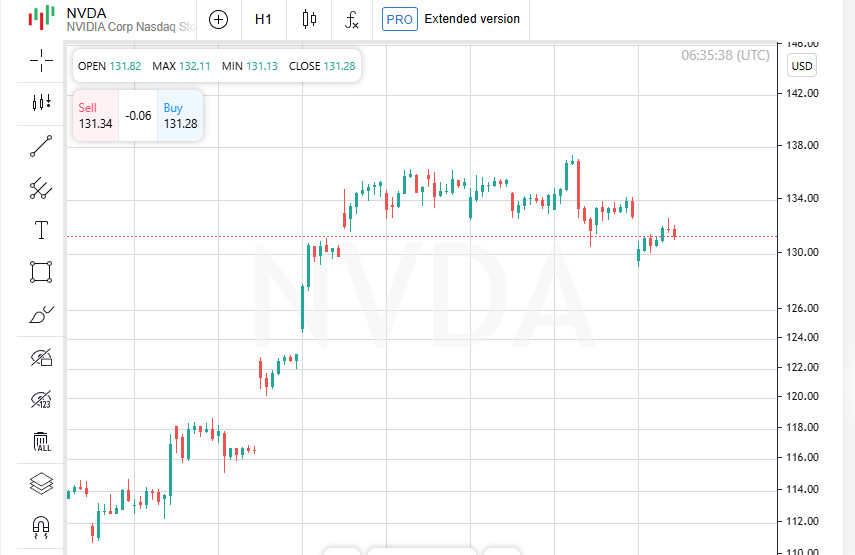Nvidia's results, the final earnings report from the Magnificent Seven, are set for release on Wednesday. Meanwhile, Donald Trump and European markets are back to square one. The 30-year US Treasury yield has surged past 5% over the past week. After a rebound, the S&P 500 has now fallen more than 5% from its record February high
Nvidia in focus: market holds its breath ahead of AI giant's report
This coming week, Wall Street's attention will center on Nvidia's quarterly earnings. As a leader in the chip sector and a critical player in the artificial intelligence race, Nvidia's performance could set the tone for the entire tech sector, especially amid mounting strain in the US bond market.
Debt pressures weigh on equities
Following weeks of sharp gains, US stock indices have taken a step back. The pullback is driven by growing unease over the country's fiscal outlook. New proposals on tax and spending policies have added fuel to the fire, with investors fearing that the already massive $36 trillion national debt could balloon further. This has pushed long-dated Treasury yields sharply higher, with 30-year bonds breaching the 5% mark and hitting their highest levels since late 2023.
Trade tensions reignite
By week's end, the situation was further inflamed by Donald Trump's sharp rhetoric. He issued threats toward the European Union and Apple, escalating talk of a potential trade confrontation. These comments sparked a new wave of anxiety across markets that are already reacting nervously to any hint of instability.
All eyes on Nvidia
The highlight of the week will be Nvidia's quarterly earnings, due Wednesday. As one of the world's largest companies by market capitalization, Nvidia plays a pivotal role in shaping broader equity index movements. Investors are hoping not just for strong numbers but also for confident signals pointing to continued growth in artificial intelligence and high-performance computing.
Meteoric rise followed by cool start to 2025
Following a spectacular surge, where Nvidia shares soared more than 1000% from late 2022 through the end of 2024, the company has entered 2025 on a calmer note. Shares are down about 2% year-to-date, though this is widely seen as a breather after an extraordinary rally rather than a red flag. Nvidia's explosive growth has been driven primarily by unprecedented demand for AI chips, which have underpinned a new wave of technological revolution and delivered record profits.
Forecasts remain upbeat: strong results expected
Financial analysts surveyed by LSEG expect Nvidia's report to reaffirm its leadership. They project net income for the first quarter could rise nearly 45%, with revenue likely reaching a staggering $43.2 billion. These figures reinforce Nvidia's standing as one of the chief beneficiaries of the AI frenzy sweeping global markets.
China factor: sanctions and billions in losses
However, not everything is smooth sailing. Geopolitical clouds are gathering on the horizon. Nvidia has already warned investors that US government restrictions on exporting advanced chips, including its flagship H20, to China could cost the company $5.5 billion. The move is part of Washington's broader strategy to control tech exports amid its standoff with Beijing. Now, investor focus extends beyond Nvidia's earnings to the mounting risks tied to global political dynamics.
Temporary relief, but risks linger
Since then, there has been a partial softening of rhetoric. Signs of a potential truce between the US and China have slightly eased tensions, helping the equity market recover some of its lost ground. Still, as of May 2025, the S&P 500 remains down 1.3% year-to-date and 5.6% below its February peak.
Fresh pressure from Trump
Friday's trading session ended with another slide following a new round of aggressive remarks from Donald Trump. He announced plans to impose 50% tariffs on imports from EU countries starting June 1, along with a proposed 25% tariff on Apple products if they are not assembled within the US. These declarations sparked a renewed wave of market anxiety and posed an additional challenge for major tech companies, including Nvidia, whose supply chains are deeply reliant on global stability.
Credit jitters: Moody's undermines confidence in US
The past week's economic narrative was dominated by one name, Donald Trump. His aggressive budget proposals and sweeping fiscal promises became the focal point for investors. Adding to the market's anxiety was a move by Moody's, which downgraded the US credit rating, citing concerns over the nation's rapidly expanding debt. The decision dealt a blow to confidence in the financial stability of the world's largest economy.
Investors shift focus to Europe
Interestingly, despite global tensions, European equities continue to attract capital. According to Morningstar, from the start of the year through May 16, European equity funds saw inflows of €34 billion, four times the €8.2 billion that flowed into US equity instruments during the same period. The data reflects growing investor confidence in Europe's prospects amid rising uncertainty in the US.
Europe's view: Eurozone's inflation barometer
This week will also bring fresh data from Europe. On Tuesday and Friday, Germany and France, two key euro area economies, will release their latest inflation figures. These reports will be critical for the European Central Bank and global investors gauging how inflationary trends in the euro area are diverging from the US trajectory. A composite consumer price index for the eurozone is expected next week.
Behind the scenes: market holds its breath
As the world braces for a new wave of economic data, investors are reluctant to place definitive bets. Tariff tensions, election uncertainties, and inflation expectations have created an intricate backdrop in which any statistical release could trigger significant market moves.












